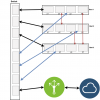Hi,
I have a 3 hosts cluster, but sometimes the migrations, replications, etc impact the performance of the VMS > internet.
The servers I am using have 4 ethernet ports, I am only using one (with cable) as of now.
I am interested in increasing the bandwidth available IN BETWEEN the hosts, so they can transfer faster in between them.
What would be the best approach to this? I prefer a solution that does not involve rebooting the hosts.
Screen shot is for one of the hosts, but they are all identical, in hardware and setup.

I think that I could accomplish this in one of 2 ways (or maybe even both) as per this image
The black links are the ones that are now in place.
The red and blue are my proposals.

Actually doing both would utilize all the NICs , which I think is the ideal case.
Now, the questions are:
what modality to use?
IP address to use? (GTW, SUBNET) currently my whole network (the VMs and real machines, DBs, etc) are in 172.21.82.0/24
For instance Hosts main ip is 172.21.82.22, hosts 3 is 172.21.82.23 ..
VM1 > windows > 172.21.82.101
VM2 > Windows > 172.21.82.102
VM5 > Linux VM > 172.21.82.205
etc ..
So, I am not sure if I should use a new set of addresses, (like for instance 10.1.10.0/24) or stick to the one I know is working fine.
Also, I know there are options in the network , like in the next image

But I have no idea (and can not really understand the technical explanations in the manual) as to what would be the best solution in my case.
Basically, I have 3 empty NICs on each server, I have plenty of ports on my switch. I would like to make it so there is not one simple point of failure and increase performance, mostly in between the hosts for replication and moving large files in between.
Thanks
I have a 3 hosts cluster, but sometimes the migrations, replications, etc impact the performance of the VMS > internet.
The servers I am using have 4 ethernet ports, I am only using one (with cable) as of now.
I am interested in increasing the bandwidth available IN BETWEEN the hosts, so they can transfer faster in between them.
What would be the best approach to this? I prefer a solution that does not involve rebooting the hosts.
Screen shot is for one of the hosts, but they are all identical, in hardware and setup.
I think that I could accomplish this in one of 2 ways (or maybe even both) as per this image
The black links are the ones that are now in place.
The red and blue are my proposals.

Actually doing both would utilize all the NICs , which I think is the ideal case.
Now, the questions are:
what modality to use?
IP address to use? (GTW, SUBNET) currently my whole network (the VMs and real machines, DBs, etc) are in 172.21.82.0/24
For instance Hosts main ip is 172.21.82.22, hosts 3 is 172.21.82.23 ..
VM1 > windows > 172.21.82.101
VM2 > Windows > 172.21.82.102
VM5 > Linux VM > 172.21.82.205
etc ..
So, I am not sure if I should use a new set of addresses, (like for instance 10.1.10.0/24) or stick to the one I know is working fine.
Also, I know there are options in the network , like in the next image

But I have no idea (and can not really understand the technical explanations in the manual) as to what would be the best solution in my case.
Basically, I have 3 empty NICs on each server, I have plenty of ports on my switch. I would like to make it so there is not one simple point of failure and increase performance, mostly in between the hosts for replication and moving large files in between.
Thanks

